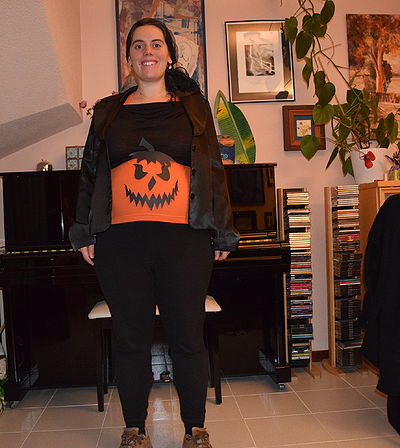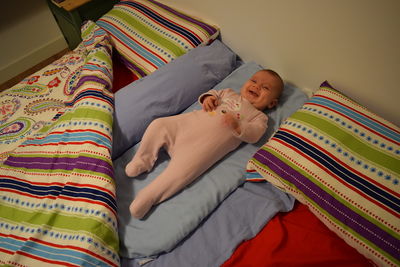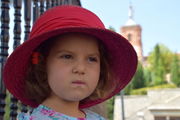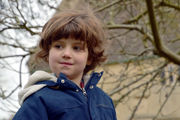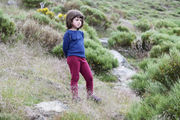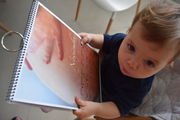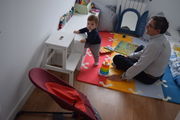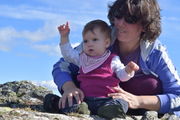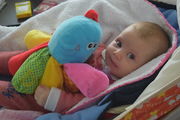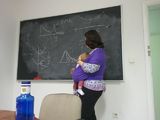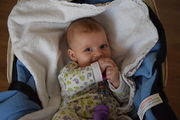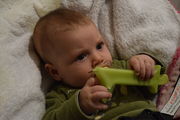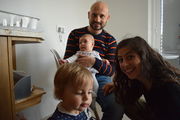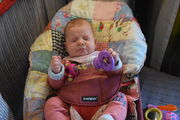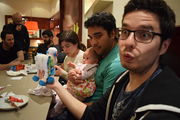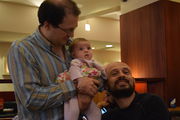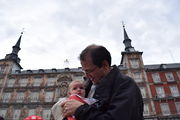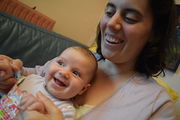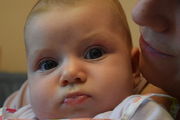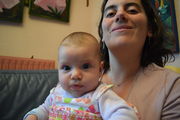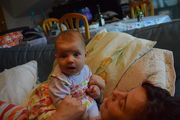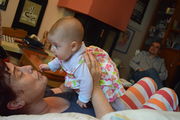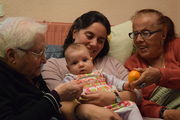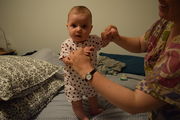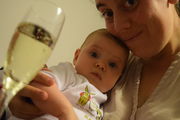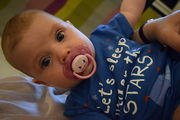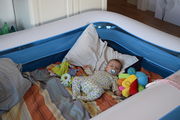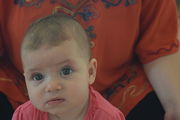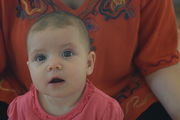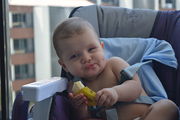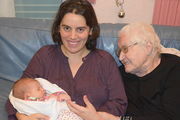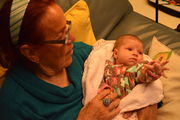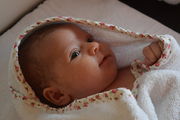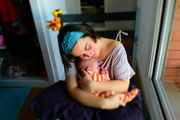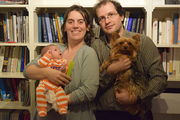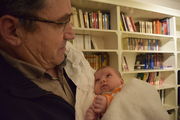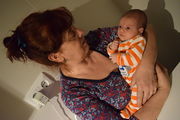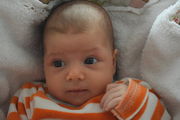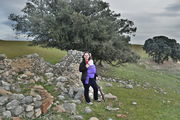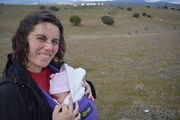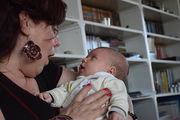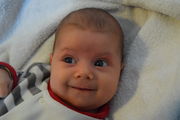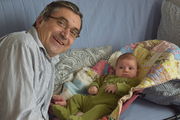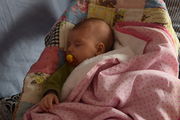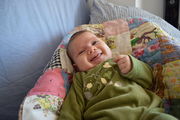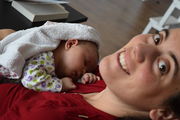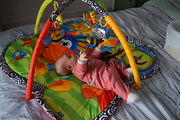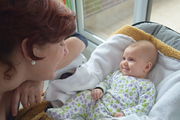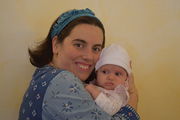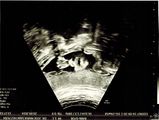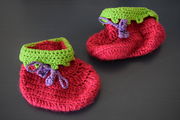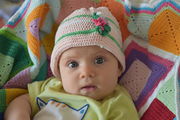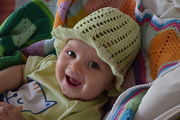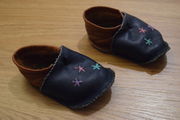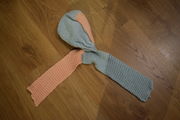|
|
| (47 intermediate revisions by 3 users not shown) |
| Line 1: |
Line 1: |
| | <center>[[File:Nombre-Julia.png|300px|link=]]</center> | | <center>[[File:Nombre-Julia.png|300px|link=]]</center> |
| | | | |
| − | Julia ({{thisday|3|January|2015}}) is our daughter, first and, so far, only child. | + | Julia ({{thisday|3|January|2015}}) is our firstling child, the elder sister of [[Luz]]. We keep track of all her achievements and important changes in [[Julia's evolution|this timeline]] and a gallery of [[Julia's drawings|her drawings here]]. |
| | | | |
| − | <center><wz tip="Julia's eyes are of undetermined colors. Sometimes they are green, as they appear here in the church of San Juan Bautista of Alarcón, reflecting the mural paintings of Jesús Mateo (July 2015).">[[Image:julia-july2015.jpg|600px]]</wz></center>
| + | She's growing extremely fast and is already {{#expr:({{#time: U | now }}-{{#time: U | 2015-01-03 }})/(365*86400) round 1}} years old. She seems to be a different person everyday! |
| | | | |
| − | == Raising Julia == | + | <center><wz tip="Julia thinking, with pen and paper, 27 December 2018.">[[File:JuliaThinking-27Dec2018.jpg|650px]]</wz></center> |
| | | | |
| − | === Attachment parenting ===
| |
| | | | |
| − | <wz tip="Nothing you do for children is ever wasted. Garrison Keillor, Leaving Home">[[Image:parenting.jpg|right|200px|thumb|[https://www.youtube.com/watch?v=KUwjNBjqR-c And the cat's in the cradle and the silver spoon. Little boy blue and the man on the moon.]]]</wz>
| + | = Julia's infancy = |
| | | | |
| − | [http://en.wikipedia.org/wiki/Attachment_parenting Attachment parenting] means to follow your instincts in parenthood which, in general, translates into being there for the baby when she needs it. That is, to pick her up when she cries, to breastfeed her [http://www.parentingscience.com/breastfeeding-on-demand.html on demand], to have her always nearby, to carry her around as much as possible (using [http://www.amormaternal.com/2011/03/como-usar-un-fular-portabebes.html#axzz3XgRZNAas baby wraps] or a [http://www.stokke.com/en-il/baby-carriers/stokke-mycarrier/2393.html baby carrier]), co-sleeping... As a result, the baby feels secure and nurtured enough ("secure attachment") to develop independence and self-confidence when ready. But above all, this is the most enjoyable way of raising your baby. | + | * [[Parenting Julia and Luz]] |
| | + | * [[Lista de cosas últiles para bebé]] |
| | + | * [[Cuentos para Julia]] inventados por [[Elena]]. |
| | | | |
| − | Some interesting sites:
| + | == Co-sleeping with Julia == |
| − | * http://www.attachmentparenting.org
| + | |
| − | * http://www.crianzaautorregulada.com/articulos/por-que-elijo-la-crianza-con-apego
| + | |
| − | | + | |
| − | The leading proponents of attachment parenting are William and Martha Sears. In Spain, the best advocate of "crianza con apego" is Dr. Carlos Gonzalez. He has written a few beautiful and fun books on the subject: [http://goo.gl/eunkTF Bésame mucho: Cómo criar a tus hijos con amor], [http://goo.gl/zdgbj2 Un regalo para toda la vida: Guía de la lactancia materna], [http://goo.gl/KlBWHg Creciendo Juntos] etc. Some interesting videos from him are: [https://www.youtube.com/watch?v=VgLHJKtxcnQ El sueño en bebés]. He says things like:
| + | |
| − | | + | |
| − | * La infancia es fugaz. Que nuestra obsesión por corregirla no nos impida disfrutarla.
| + | |
| − | * Yo no dejaría jamás llorar a mi hijo. Ni a mi esposa, ni a mis padres ni a mis amigos. Cuando una persona a la que quiero llora, voy a ver qué le pasa e intento consolarla.
| + | |
| − | * Malcriar significa criar mal, con poco cariño, sin cubrir las necesidades básicas del niño.
| + | |
| − | | + | |
| − | La crianza con apego suele despertar muchas críticas pero todas son bastante [http://www.amormaternal.com/2011/09/desmintiendo-creencias-mitos-crianza.html#axzz3XgRZNAas rebatibles]...
| + | |
| − | | + | |
| − | === Co-sleeping ===
| + | |
| | | | |
| | <wz tip="Julia enjoying her cosleeping setup.">[[Image:cosleeping-julia-14-april-2015-p.JPG|right|400px]]</wz> | | <wz tip="Julia enjoying her cosleeping setup.">[[Image:cosleeping-julia-14-april-2015-p.JPG|right|400px]]</wz> |
| − |
| |
| − | It is a sensible and practical thing to do, as many [https://www.youtube.com/watch?v=TlEyT8W5dOw people put it], although there are also studies and interesting books to read on the subject. The most famous one is [http://www.amazon.com/Sleeping-Your-Baby-Parents-Cosleeping/dp/1930775342 Sleeping with your baby] by [https://www.youtube.com/watch?v=XCZzzqFkyiU James J. McKenna].
| |
| | | | |
| | Quite naturally, we have been drifting towards co-sleeping with Julia, not only room but also bed sharing. | | Quite naturally, we have been drifting towards co-sleeping with Julia, not only room but also bed sharing. |
| Line 41: |
Line 28: |
| | It feels completely natural. It also facilitates breastfeeding since it allows me and Julia to barely wake up and go back to sleep without any problem most of the nights. When she does wakes up, I know it instantly and can react quickly to her demands so that she is never fully awake, does not get to the point of crying and does not choke. Cry-less nights! Already interesting. But cosleeping goes further than just these convenient and practical reasons. I love to sleep so close to this beautiful baby, wake up in the mornings to her joyful smile. If she is a bit excited at bed time, I simply caress her and hold her hands for a little while and she quietly and smoothly falls asleep. It feels right and both Fabrice and me, enjoy it immensely. | | It feels completely natural. It also facilitates breastfeeding since it allows me and Julia to barely wake up and go back to sleep without any problem most of the nights. When she does wakes up, I know it instantly and can react quickly to her demands so that she is never fully awake, does not get to the point of crying and does not choke. Cry-less nights! Already interesting. But cosleeping goes further than just these convenient and practical reasons. I love to sleep so close to this beautiful baby, wake up in the mornings to her joyful smile. If she is a bit excited at bed time, I simply caress her and hold her hands for a little while and she quietly and smoothly falls asleep. It feels right and both Fabrice and me, enjoy it immensely. |
| | | | |
| − | === Baby-led weaning ===
| + | == Baby-led weaning == |
| | | | |
| | Baby-led weaning lets the weaning process in the hands of the baby. This is the method we have chosen and you can follow our progress in our page on "[[Julia-led weaning]]". | | Baby-led weaning lets the weaning process in the hands of the baby. This is the method we have chosen and you can follow our progress in our page on "[[Julia-led weaning]]". |
| | | | |
| − | === Growing up with several languages ===
| + | == Growing up with several languages == |
| | | | |
| | Cada uno hablamos a Julia en nuestro idioma materno, Elena en español y Fabrice en francés. Este es el método más practicado en el multilingüismo ([http://www.multilingualchildren.org/getting_started/language_system.html One person one language]). | | Cada uno hablamos a Julia en nuestro idioma materno, Elena en español y Fabrice en francés. Este es el método más practicado en el multilingüismo ([http://www.multilingualchildren.org/getting_started/language_system.html One person one language]). |
| Line 51: |
Line 38: |
| | Las primeras palabras de Julia fueron papá y mamá en el mismo día, mientras viajábamos en el tren nocturno de Moscú a St Petersburgo. Lo grabamos en [https://www.youtube.com/watch?v=mraOKFn2MeU&feature=youtu.be vídeo]. | | Las primeras palabras de Julia fueron papá y mamá en el mismo día, mientras viajábamos en el tren nocturno de Moscú a St Petersburgo. Lo grabamos en [https://www.youtube.com/watch?v=mraOKFn2MeU&feature=youtu.be vídeo]. |
| | | | |
| − | === Playful parenting === | + | = Pictures = |
| | | | |
| − | [http://www.amazon.com/Parent-Effectiveness-Training-Responsible-Children/dp/0609806939 PET parenting], [http://goo.gl/A3Oxnp Playful parenting]
| + | == Gallery == |
| | | | |
| − | === Education and creativity === | + | <gallery widths=200px perrow=3> |
| | + | File:Julia-CerroLosAngeles-24Aug18-1.jpg|En el [[Cerro de los Ángeles]], {{thisday|24|August|2018}}. |
| | + | File:Woolsthorpe-26Jan20-7.jpg|With [[Newton]]'s apple tree & manor in [[Woolsthorpe]], {{thisday|26|January|2020}}. |
| | + | File:Julia-30April2020.jpg|Working on a [[Julia's drawings|drawing]] (after putting some make-up stolen to her mum), {{thisday|30|April|2020}}. |
| | + | File:julia-Najarra-14June20.jpg|Pensative while [[hiking]] the [[Najarra]], on {{thisday|14|June|2020}}. |
| | + | </gallery> |
| | | | |
| − | <wz tip="The moment you doubt whether you can fly, you cease for ever to be able to do it. J.M. Barrie, Peter Pan">[[Image:room-child.jpg|right|150px]]</wz>
| + | === Fourth trimester === |
| | | | |
| − | "The best teachers are those who show you where to look, but don't tell you what to see". Alexandra K. Trenfor
| + | <gallery widths=200px perrow=3> |
| − | | + | File:Julia-november-2015-DSC_0500.JPG |
| − | * [http://www.educacionprohibida.com La educación prohibida]: Una película sobre la educación centrada en el amor, el respeto, la libertad y el aprendizaje. ("¿Pero no quieres tener un título, ser alguien en la vida? Yo ya soy alguien en la vida!")
| + | File:Julia-november-2015-DSC_0534.JPG |
| − | * [http://www.born-to-learn.org Born to learn] is a fun, thought-provoking series of animations that illustrate ground-breaking new discoveries about how humans learn. Also [http://www.responsiblesubversives.org Responsible Subversive], a social network for people who want to connect and discuss how to change the world by changing the way we raise our children.
| + | File:Julia-november-2015-DSC_0638.JPG |
| − | | + | File:Julia-november-2015-DSC_0643.JPG |
| − | * [http://www.youtube.com/watch?v=i07qz_6Mk7g ¿Te atreves a soñar?] by [http://www.inknowation.com/es inKNOWation España].
| + | File:Julia-november-2015-DSC_0649.JPG |
| − | * [https://www.youtube.com/watch?v=zDZFcDGpL4U Changing Education Paradigms], by [http://es.wikipedia.org/wiki/Ken_Robinson Ken Robinson] [https://www.youtube.com/playlist?list=PL39BF9545D740ECFF&feature=plcp RSAnimated]
| + | File:JuliaTejeraNegra-7Nov15.jpg|In the mountains of the Tejera Negra, {{thisday|7|November|2015}}. |
| − | * [https://www.youtube.com/watch?v=bqK-AJyOZEk Where good ideas come from?], by [http://en.wikipedia.org/wiki/Steven_Johnson_(author) Steven Johnson], RSAnimated
| + | </gallery> |
| − | * [https://www.youtube.com/watch?feature=player_embedded&v=u6XAPnuFjJc Drive: The surprising truth about what motivates us], by [http://en.wikipedia.org/wiki/Dan_Pink Dan Pink], RSAnimated
| + | |
| − | * [http://www.youtube.com/watch?v=l7AWnfFRc7g The Empathic Civilisation] (by [http://en.wikipedia.org/wiki/Jeremy_Rifkin Jeremy Rifkin], RSAnimated)
| + | |
| − | * [https://www.youtube.com/watch?feature=player_embedded&v=siu6JYqOZ0g What if money was no object?] by [http://es.wikipedia.org/wiki/Alan_Watts Alan Watts]
| + | |
| − | * [[File:On_the_Psychology_of_Scientific_Creativity--Migdal.pdf]] by A. B. Migdal (L. D. Landau Institute of Theoretical Physics, Moscow), Contemporary Physics, 20, 121 (1979).
| + | |
| − | | + | |
| − | http://didacticaeducacioninfantil.wikispaces.com/
| + | |
| − | | + | |
| − | | + | |
| − | ==== Resources for Infant Educarers (RIE) ====
| + | |
| − | | + | |
| − | Emmi Pikler & Magda Gerber
| + | |
| − | | + | |
| − | * http://www.magdagerber.org/
| + | |
| − | * http://pikler.org/PiklerPractices.html
| + | |
| − | * http://www.janetlansbury.com/2013/12/rie-parenting-basics-9-ways-to-put-respect-into-action/
| + | |
| − | * http://babygooroo.com/2014/04/rie-parenting/
| + | |
| − | | + | |
| − | Great blog: http://goodjobandotherthings.com ([http://goodjobandotherthings.com/pov/rie/what-does-it-mean/ What is it?])
| + | |
| − |
| + | |
| − | [http://www.essentialbaby.com.au/baby/baby-education-and-play/the-truth-about-rie-parenting-20140217-32v3i.html Summary from an article]:
| + | |
| − | | + | |
| − | 1. Talk to your baby
| + | |
| − | | + | |
| − | RIE recommends informing your baby about what you are going to do before you do it, such as ‘I’m going to pick you up now’. This doesn’t mean that lullabies and gooing and gagaing are out. Rather, it means that children will be less anxious if they are told what is going to happen to them before it happens. It will also help with their language development.
| + | |
| − | | + | |
| − | 2. Let your baby cry
| + | |
| − | | + | |
| − | ‘When your baby cries…wait,’ writes Carlisle Solomon.
| + | |
| − | | + | |
| − | This isn't laziness or neglect. Instead, it allows you to observe and work out the cause of the distress, and it gives your baby the opportunity to learn how to self-soothe and the freedom to express their emotions.
| + | |
| − | | + | |
| − | ‘Don’t distract your baby from her feelings by bouncing her on your knee or singing a cheery song,’ writes Carlisle Solomon. ‘Trying to jolly your baby out of crying will only make her feel disconnected and out of tune with you. Imagine if you were upset and your trusted other responded with a big grin, spoke in a singsongy voice, and tried to humor you out of it.’
| + | |
| − | | + | |
| − | 3. Dummies
| + | |
| − | | + | |
| − | RIE is not anti-dummies as has been reported. Instead, Carlisle Solomon cautions against forcing a dummy into a child’s mouth if it clearly doesn’t want it.
| + | |
| − | | + | |
| − | ‘If you choose to offer a pacifier, it’s very important that as soon as you see your baby push the pacifier out of her mouth when it’s offered, you put it away.’
| + | |
| − | | + | |
| − | 4. Caring routines
| + | |
| − | | + | |
| − | Rather than seeing routines such as nappy changing, bathing and feeding as labourious tasks to be rushed through, try to slow down and use them as a caring opportunity to communicate and bond.
| + | |
| − | | + | |
| − | ‘[T]his helps the baby feel secure because he learns to anticipate what will happen next and can participate when he is able.’
| + | |
| − | | + | |
| − | 5. Baby-led feeding
| + | |
| − | | + | |
| − | According to RIE parenting, part of respecting your child is also respecting their appetite.
| + | |
| − | | + | |
| − | ‘Babies should never be coaxed, cajoled, or forced to eat. They should eat however much they want, and not one bite more!’ writes Carlisle Solomon.
| + | |
| − | | + | |
| − | ‘To help baby learn to eat when he’s hungry and stop eating when he’s satiated, we need to observe closely so that we’re attuned to his cues. Then we need to honor what the baby communicates to us.’
| + | |
| − | | + | |
| − | 6. Prioritise your baby’s sleep schedule
| + | |
| − | | + | |
| − | RIE considers adequate sleep to be essential for a happy, healthy baby and a calm family. This means establishing a sleep routine and prioritising it — even when granny drops in and wants a cuddle.
| + | |
| − | | + | |
| − | The principle of allowing babies to cry so they learn to self-sooth also applies to sleeping — within reason.
| + | |
| − | | + | |
| − | ‘Of course, if your baby’s crying is ramping up and she’s sounding distressed, then by all means, go into her room to reassure her. It’s best to go to her before she’s so over-wrought that she needs a lot of help to calm.’
| + | |
| − | | + | |
| − | 7. Limiting intervention
| + | |
| − | | + | |
| − | Rather than rushing in to solve our children’s problems we should allow them the opportunity to find their own solutions and to discover and cope with the fact that life involves struggle, disappointment and compromise.
| + | |
| − | | + | |
| − | ‘When an adult routinely steps in to solve every little, or big problem, a baby can quickly learn to look for help rather than attempt to find a solution for himself, and giving up and relying on an adult for every little thing becomes a habit,’writes Carlisle Solomon.
| + | |
| − | | + | |
| − | ‘Not only is a child robbed of a sense of self-satisfaction and accomplishment, but his sense of confidence and self-reliance can begin to erode as well.’
| + | |
| − | | + | |
| − | 8. Toys
| + | |
| − | | + | |
| − | This is one of the most misreported aspects of RIE. The philosophy is not anti-toys, but instead recommends simple toys such as a cotton napkin, plastic hair rollers, colanders, pot holders, plastic nesting cups, or an empty plastic bottle.
| + | |
| − | | + | |
| − | '''According to this philosophy, the more passive the toy, the more active the child needs to be to play with it.'''
| + | |
| − | | + | |
| − | 9. Praise
| + | |
| − | | + | |
| − | RIE is not against praising children as has been reported. But instead of telling your child they are as talented as Rembrandt every time they pick up a crayon, Carlisle Solomon recommends praising kids for doing difficult social or process things like waiting, sharing or persistence.
| + | |
| − | | + | |
| − | In other instances, parents should ‘reflect what we see instead of praising.’ For example: ‘You got those rings apart’ or 'You put the nesting cups together.’
| + | |
| − | | + | |
| − | As with any parenting philosophy, it’s unlikely that every recommendation fits every family and every child. But amongst the other parenting trends from Tiger Moms and Helicopter Parenting, RIE seems pretty tame.
| + | |
| − | | + | |
| − | ? Allow your baby to participate in childcare. Tell your child what you'll do before you do it. Informing him about what will happen next -- like a diaper change -- can help him feel more secure and lead to two-way communication down the road, says O'Sullivan.
| + | |
| − | | + | |
| − | ? Honor what he can do physically. The group suggests not putting a baby into a position he can't get into himself, such as propping him up with pillows in a sitting position. Healthy babies will invariably reach these developmental milestones, argues RIE, and rushing the process may frustrate them and even lead them to feel disappointed in themselves.
| + | |
| − | | + | |
| − | ? Sit and observe. To see your child for who he is and witness small development changes as they occur, RIE advocates that parents watch their child play, without distractions or planned activities, ideally for at least 15 minutes three times a day. Occasionally, the parent should comment nonjudgmentally about the child's activity -- "sportscasting" in the RIE lingo.
| + | |
| − | | + | |
| − | ? Follow your baby's lead. During playtime, let him choose a toy or a new place to explore. That means making your home baby-safe is critical, so your child can have more freedom to wander. In the spirit of doing less, RIE asserts that a child who is frustrated by, say, a ball that has rolled under a chair shouldn't be helped immediately. Finding his own solutions can make for a more valuable lesson.
| + | |
| − | | + | |
| − | ? Turn off the television. Playing without the distraction of the TV lets your child decide what interests him and may even help him develop concentration.
| + | |
| − | | + | |
| − | 1. ONE PRIMARY CAREGIVER: An infant needs an intimate, stable relationship with one constant person with whom they “attach.” This is necessary for the healthy psychological and physical development of the infant and a pre-requisite for the child’s ability form secure relationships later in life. Secondary caregivers—another parent, grandparent, nanny or carer—are important but too many can be destabilizing.
| + | |
| − | | + | |
| − | 2. NARRATE AND ENCOURAGE PARTICPATION: Tell your child what you are going to do to or with him before you do it—”I’m going to pick you now. Are you ready?”— then wait for a response. (A clear response may be hard to detect from a newborn but soon you’ll be able to read his face and then surprisingly quickly you’ll notice that he’ll begin to lift his arms.) This allows babies—who are extraordinarily vulnerable—to relax because they know you’re not going to just move their bodies without fair warning. Also, engaging your child makes him feel respected and builds initiative and competence.
| + | |
| − | | + | |
| − | 3. CONNECT DURING CAREGIVING TIMES: Dressing, changing, feeding and bathing your child are ideal times to slow way down and really connect. These are your opportunities to fill up your child’s emotional gas tanks so she can have the love and connection she needs to go off to explore and play with confidence.
| + | |
| − | | + | |
| − | 4. SELF-INITIATED PLAY: From the earliest age, give your baby plenty of uninterrupted time on the floor (on a blanket or mat) to move as she wants and to discover her surroundings. A child’s attention should not be drawn to a toy by placing it in his hand, pointing to it or dangling it overhead. Instead, your child should explore and investigateer h of their own choosing—be it a toy, a shadow or the sound her foot makes banging the floor—for as long as she finds it compelling. This is at once self-satisfying and builds her attention span.
| + | |
| − | | + | |
| − | 5. SENSITIVE OBSERVATION: The best way to get to know your child is by observing him. This means just hanging out in his play area (ideally, every day) for twenty minutes (but five will do!). Be present, available and totally focused on what he is doing, without telling him what to do, how to do it or interrupt his play in any way. Through observation, you’ll intimately get to know his needs, interests, abilities, frustrations, duration of attention span and more.
| + | |
| − | | + | |
| − | 6. PASSIVE TOYS MAKE ACTIVE BABIES: Provide your child with simple toys that can be used in a variety of ways to encourage her imagination, creativity, attention span, competence and understanding of properties like gravity, weight, size, shape, malleability, balance etc. (This means no toys with songs, bells, whistles, sirens and certainly no television.)
| + | |
| − | | + | |
| − | 6. LET YOUR CHILD DEVELOP IN HER OWN TIME: Allow your child to roll over, sit up, stand up and walk only when her muscles and bones are ready to. The negative consequences of rushing development are incalculable.
| + | |
| − | | + | |
| − | 7. SAFE PLAY SPACE: Create a safe space where he can play and never have to hear “No, don’t touch that.” This way you can relax, and your child won’t need to unnecessarily feel like he’s done something wrong. | + | |
| − | | + | |
| − | 8. ESTABLISH A ROUTINE: If your child’s days are consistent and predictable, she’ll start to anticipate what will come next. When what she thinks will come next actually does, her sense of security is reinforced.
| + | |
| − | | + | |
| − | 9. OUTDOOR TIME: Children need time outdoors—even newborns. You can bundle them up or strip them down as the weather dictates. Being surrounded by nature—leaves rustling, wind blowing, clouds moving, sun shining and ants crawling—is at once soothing and intriguing.
| + | |
| − | | + | |
| − | 10. AVOID CONTRAPTIONS AND LIMIT TIME IN CAR SEATS AND STROLLERS: While certainly car seats are necessary and strollers are helpful up to a point, putting a baby into play centers, exersaucers, walkers, swings and bouncy seats restricts a baby’s freedom to move and develop in a natural way. Also, overusing infant seats and strollers for “convenience” deprives babies of the human touch they need for optimal brain development. And finally, using swings and seats that vibrate to help soothe or induce sleep can create a dependency that can be challenging to break.
| + | |
| − | | + | |
| − | 11. TIME WITH OTHER BABIES: Infants learn a great deal from each other, even at an early age. Allow interactions and explorations between babies to unfold without rushing in to sweep the babies away from one another. You can monitor them to make sure they are safe, but allowing contact is healthy.
| + | |
| − | | + | |
| − | 12. TRUST YOUR CHILD’S INTERNAL REGULATOR. Give your child less food so she’ll ask for more. If your child indicates she isn’t hungry, believe her. Never ask her to take one more bite.
| + | |
| − | | + | |
| − | 13. CHILD-INITIATED EATING: When a child can sit up, eating on a stool that is easy to climb on and off at a child-sized table promotes independence. This way the child can come to the table when hungry and simply crawl or walk away to play when full. If he chooses to play, he cannot take his food. This process teaches making choices.
| + | |
| − | | + | |
| − | 14. EXPECTATIONS SHOULD BE DEVELOPMENTALLY APPROPRIATE: Don’t expect her to have self-control when her brain is too immature to have developed self-control. Don’t expect him to empathize before he is old enough to have developed empathy. This only sets them up for failure.
| + | |
| − | | + | |
| − | 15. BE SUPER CONSISTENT: Choose your no’s carefully and then mean them. Nothing creates a neurotic kid faster than saying, “No you can’t have that,” and then ten minutes of crying later, caving in.
| + | |
| − | | + | |
| − | 16. ALLOW YOUR CHILD TO EXPRESS HER FEELINGS: If your child is angry, let them be angry. Don’t try to solve his problem, distract him or make him happy. If the anger isn’t released from his body, it creates stress. Trying to fix things for him will give him the message that not all feelings are okay. Children, like everyone, need to feel heard and understood. Sometimes they need you to empathize. Sometimes they want to be held. Other times they need space. Waiting and observing helps you respond helpfully. Also, naming feelings (i.e. “You seem angry.” or “You seem frustrated.”) not only gives a helpful vocabulary to identify their feelings, it shows that you’re tuned in.
| + | |
| − | | + | |
| − | 17. REFLECT RATHER THAN PRAISE: Reflecting or acknowledging “achievements” (and I use that word reluctantly) is more helpful than praising. “Yes, you jumped off the rock!” instead of “Good job!” allows you to share in your child’s excitement, but in a way that mirrors how they feel, not how you judge it.
| + | |
| − | | + | |
| − | 18. PLAN FOR TARRY TIME: Children operate on slower timetables than adults. If you know it takes your kid twenty minutes to walk to the car because she likes to stop and admire the flowers or count the steps or trace the hubcap with her finger, then head out to the car long before you would if you were alone. This way, your child won’t feel rushed or pressured and you can prevent the meltdowns that make things take even longer. Certainly, you can’t always do this—but the more often you do, the more likely she’ll cooperate when you are in a rush.
| + | |
| − | | + | |
| − | 19. VALUE STRUGGLE / SELECTIVE INTERVENTION: When possible, trust that your baby can solve his own problems. If he can’t get the blocks on his tower to balance the way he wants to, you can come close and offer support while seeing if he can figure it out on his own. This builds perseverance, self-reliance, ingenuity and fosters pride in oneself. Similarly, if two babies/toddlers are struggling over a toy, come close, keep them safe and state the problem: “I see you both want the truck.” This lets them know you understand what they are dealing with and also prevents creating a victim-aggressor dynamic. (An aggressive response only reinforces aggressive behavior and too much fussing over the “victim” becomes enjoyable for that person.) Surprisingly often, the children are able resolve their conflict and move on without assistance.
| + | |
| − | | + | |
| − | 20. DON’T OVERREACT: Not every fall needs a level ten response. You want your kids to know you are concerned and are there if they need you, but that they can also handle minor snafus on their own. Your upset can scare a child and amplify her response. Come close to the child and empathize, but let the child choose if she wants to be held. This response helps a child be more authentic.
| + | |
| − | | + | |
| − | 21. DON’T HUMILIATE: Don’t talk about your child in the third person in front of them, “You wouldn’t believe what Derek did…”). Don’t chastise him loudly in front of others. (If he does something you don’t like while playing in a group, kneel down and whisper in his ear, “I don’t like it when…”). Don’t mock him or roll your eyes at him when he’s talking.
| + | |
| − | | + | |
| − | 22. DON’T ASK YOUR CHILD TO PERFORM: Don’t ask your child to perform for you or for family, or for friends. This includes things as seemingly harmless as saying “Can you tell me what color this is?” or asking your child to sing a song. Children should not be expected to be sources of on-demand entertainment. Likewise, don’t make or even encourage them to kiss or hug you or anyone else as in “Can you give Grandma a kiss?” Physical expressions of love should come from a genuine place.
| + | |
| − | | + | |
| − | 23. BE HONEST: If you are upset with your child, don’t try to act like you aren’t. If she senses one thing (anger and annoyance) but hears another (“sweetheart”) it’s confusing and makes it hard for her to both trust her instincts and you. (If you are upset, try to model how to deal with your frustration and anger, remembering that little eyes are always watching and learning.)
| + | |
| − | | + | |
| − | 24. DON’T LABEL: Labeling your child anything—be it “shy” “energetic” or “a little monster” (even in jest)— gives them scripts that they then live up to.
| + | |
| − | | + | |
| − | [http://evolutionaryparenting.com/my-problems-with-rie/ critics]
| + | |
| − | | + | |
| − | ==== Montessori ====
| + | |
| − | | + | |
| − | http://didacticaeducacioninfantil.wikispaces.com/Las+escuelas+Montessori
| + | |
| − | | + | |
| − | The problem of applying it at a young age...
| + | |
| − | | + | |
| − | * http://piklerexperience.blogspot.com.es/2012/01/montessori-vs-pikler.html
| + | |
| − | | + | |
| − | ==== Waldorf ====
| + | |
| − | | + | |
| − | http://didacticaeducacioninfantil.wikispaces.com/Las+escuelas+Waldorf
| + | |
| − | | + | |
| − | == Pictures ==
| + | |
| | | | |
| | === Second trimester === | | === Second trimester === |
| Line 271: |
Line 105: |
| | | | |
| | <gallery widths=200px perrow=3> | | <gallery widths=200px perrow=3> |
| − | File:Julia-1stTrimester-1.jpg|Julia conoce a su bisabuela Conchi, | + | File:Julia-1stTrimester-1.jpg|Julia conoce a su [[Abuela Conchi|bisabuela Conchi]], |
| | File:Julia-1stTrimester-2.jpg|y a su bisabuela Modesta. | | File:Julia-1stTrimester-2.jpg|y a su bisabuela Modesta. |
| | File:Julia-1stTrimester-3.jpg | | File:Julia-1stTrimester-3.jpg |
| Line 329: |
Line 163: |
| | File:Julia-4-meses-03--gorro-rosa.JPG|Mayo 2015. | | File:Julia-4-meses-03--gorro-rosa.JPG|Mayo 2015. |
| | File:Julia-4-meses-04--sombrero-margaritas.JPG|Mayo 2015. | | File:Julia-4-meses-04--sombrero-margaritas.JPG|Mayo 2015. |
| | + | File:Julia-november-2015-DSC_0652.JPG|Primeros zapatitos de Julia (de piel), Octubre 2015. |
| | + | File:Julia-november-2015-DSC_0654.JPG|Gorro-bufanda para el invierno, Octubre 2015. |
| | </gallery> | | </gallery> |
| | | | |
| | == Regalos de Julia y para Julia == | | == Regalos de Julia y para Julia == |
| | | | |
| − | === Cumple de papá === | + | === Para Julia === |
| | + | |
| | + | * 2015: |
| | + | ** Papá Noel le trajo un libro desplegable de la Navidad y el piano de madera pequeño negro. |
| | + | |
| | + | * 2016: |
| | + | ** Por su 1 cumpleaños... |
| | + | ** Los Reyes... |
| | + | ** Papá Noel le trajo una pizarra con tizas y borrador y un libro de las 4 estaciones con música de Vivaldi. |
| | + | |
| | + | * 2017: |
| | + | ** Por su 2 cumpleaños, el cubo de dar vueltas (Moluk - Bilibo). Los abus, la casita de madera con muebles y muñequitos. Los tíos, un carrito de pasero con mochila y un muñeco. |
| | + | ** Por reyes, un libro de comic sin texto. |
| | + | ** Papá Noel le trajo un vestido de flamenca azul. |
| | + | |
| | + | * 2018: |
| | + | ** Por su 3 cumpleaños, le regalamos un libro "Wild", los abus el coche rojo de pedales, los tíos el maletín de médico con la bata, Guille un cajón flamenco pequeño y Hala una muñeca morada. |
| | + | ** Por reyes, en nuestra casa un aro hula-hop, el libro del cascanueces y otro de Lulú. En casa de los abus un tutú verde y una corona de flores. |
| | + | |
| | + | * 2019: |
| | + | ** Por su 4 cumpleaños, le regalamos una bici de mayores, sin ruedines, los abus, las estrellas fluorescentes para poner en las paredes de la habitación, los tíos, el libro del Patito feo moderno, Guille un montón de globos inflables. La familia de Francia, la pequeña campervan de juguete. Nosotros libros. |
| | + | ** Por reyes, en nuestra casa el xilófono. En casa de los abus la luna para poner en la pared. |
| | + | |
| | + | === De Julia: Cumple de papá === |
| | | | |
| | Para su 38 cumpleaños, el 30 de septiembre de 2015 (usando el programa [http://plasq.com/apps/comiclife/macwin Comic life]): | | Para su 38 cumpleaños, el 30 de septiembre de 2015 (usando el programa [http://plasq.com/apps/comiclife/macwin Comic life]): |
| Line 348: |
Line 207: |
| | File:Page_9.jpg | | File:Page_9.jpg |
| | </gallery> | | </gallery> |
| | + | |
| | + | Por Papá Noel 2017: un llavero con su foto del tren del Ríotinto. |
She's growing extremely fast and is already 9.3 years old. She seems to be a different person everyday!
Quite naturally, we have been drifting towards co-sleeping with Julia, not only room but also bed sharing.
For her first month, Julia would sleep in our baby stroller cradle, which in our case is removable. We started by placing it on the floor, next to my side of the bed, in order to see her from above during her sleep. Soon enough Fabrice suggested to plug her onto our (large, 160cm-) bed, between us, and that worked even better since I could help her to sleep quite easily without getting up. Just stroking her head or putting back her fallen-out pacifier. Still, after a couple of weeks, it felt like that extra barrier was not needed and things could be made even easier. Even being so physically close to us, Julia would wake up the moment she was placed in the cradle if not deeply asleep. This was annoying... Specially at 3am after gently and quite successfully breastfeeding her to sleep. Furthermore, the fact that we had a trip to France soon ahead of us made me wish we did not need the cradle (we have a rather small car).
By the second month we decided to remove it completely. We placed Julia on the bed, between us, on her little mattress (in order to give us a sense of the room she was taking) and barricaded by Fabrice's side with a pillow. They say that breastfeeding mothers are really tuned to their babies and would never roll onto them, also tend to synchronise their sleep patterns. I quickly realised that this was completely true and I sleep happily in close proximity without any fear. However, for fathers, things are not as natural. They typically fall into a much deeper sleep and need time to develop the instinct to keep the baby safe. This is why we have this pillow, that is covered by a sheet so that it is fixed and there is no risk of falling on top of Julia.
We also follow all the usual recommendations not to have extra pillows or toys or blankets in bed, not to leave any space where she could fall into and not take drugs or alcohol.
It feels completely natural. It also facilitates breastfeeding since it allows me and Julia to barely wake up and go back to sleep without any problem most of the nights. When she does wakes up, I know it instantly and can react quickly to her demands so that she is never fully awake, does not get to the point of crying and does not choke. Cry-less nights! Already interesting. But cosleeping goes further than just these convenient and practical reasons. I love to sleep so close to this beautiful baby, wake up in the mornings to her joyful smile. If she is a bit excited at bed time, I simply caress her and hold her hands for a little while and she quietly and smoothly falls asleep. It feels right and both Fabrice and me, enjoy it immensely.
Baby-led weaning lets the weaning process in the hands of the baby. This is the method we have chosen and you can follow our progress in our page on "Julia-led weaning".
Cada uno hablamos a Julia en nuestro idioma materno, Elena en español y Fabrice en francés. Este es el método más practicado en el multilingüismo (One person one language).
Las primeras palabras de Julia fueron papá y mamá en el mismo día, mientras viajábamos en el tren nocturno de Moscú a St Petersburgo. Lo grabamos en vídeo.
Por Papá Noel 2017: un llavero con su foto del tren del Ríotinto.


